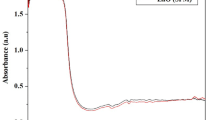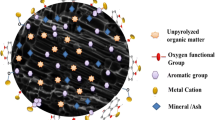Abstract
Indigenous bacterial strain Pseudomonas balearica SAE1, tolerant to e-waste toxicity was isolated from an e-waste recycling facility Exigo Recycling Pvt. Ltd., India. Toxicity tolerance of bacterial strain was analyzed using crushed (particle size ≤150 µm) waste computer printed circuit boards (PCBs)/liter (L) of culture medium. The EC50 value for SAE1 was 325.7 g/L of the e-waste pulp density. Two-step bioleaching was then applied to achieve the dissolution of gold (Au) and silver (Ag) from the e-waste. To maximize precious metal dissolution, factors including pulp density, glycine concentration, pH level, and temperature were optimized. The optimization resulted in 68.5 and 33.8% of Au and Ag dissolution, respectively, at a pH of 9.0, a pulp density of 10 g/L, a temperature of 30 °C, and a glycine concentration of 5 g/L. This is the first study of Au and Ag bioleaching using indigenous e-waste bacteria and its analysis to determine e-waste toxicity tolerance.



Similar content being viewed by others
References
Amiri F, Mousavi S, Yaghmaei S, Barati M (2012) Bioleaching kinetics of a spent refinery catalyst using Aspergillus niger at optimal conditions. Biochem Eng J 67:208–217
Arshadi M, Mousavi S (2015) Enhancement of simultaneous gold and copper extraction from computer printed circuit boards using Bacillus megaterium. Bioresour Technol 175:315–324
Baldé C, Wang F, Kuehr R, Huisman J (2015) The global e-waste monitor-2014; United Nations University, IAS–SCYCLE: Bonn
Bizzo WA, Figueiredo RA, de Andrade VF (2014) Characterization of printed circuit boards for metal and energy recovery after milling and mechanical separation. Materials 7(6):4555–4566
Brandl H, Bosshard R, Wegmann M (2001) Computer-munching microbes: metal leaching from electronic scrap by bacteria and fungi. Hydrometallurgy 59(2):319–326
Brandl H, Lehmann S, Faramarzi MA, Martinelli D (2008) Biomobilization of silver, gold, and platinum from solid waste materials by HCN-forming microorganisms. Hydrometallurgy 94(1):14–17
Cayumil R, Khanna R, Rajarao R, Mukherjee P, Sahajwalla V (2016) Concentration of precious metals during their recovery from electronic waste. Waste Manage 57:121–130
Chen B-Y, Liu H-L, Chen Y-W, Cheng Y-C (2004) Dose–response assessment of metal toxicity upon indigenous Thiobacillus thiooxidans BC1. Process Biochem 39(6):737–748
Chi TD, Lee J-c, Pandey B, Yoo K, Jeong J (2011) Bioleaching of gold and copper from waste mobile phone PCBs by using a cyanogenic bacterium. Miner Eng 24(11):1219–1222
Clinical Laboratory Standards Institute (2013) Performance standards for antimicrobial disk and dilution susceptibility tests for bacteria isolated from animals; approved standard—Fourth Edition. VET01-A4. Wayne: CLSI
Cossu R, Williams ID (2015) Urban mining: concepts, terminology, challenges. Waste Manag 45:1–3. doi:10.1016/j.wasman.2015.09.040
Cui J, Zhang L (2008) Metallurgical recovery of metals from electronic waste: a review. J Hazard Mater 158(2):228–256
Faramarzi MA, Stagars M, Pensini E, Krebs W, Brandl H (2004) Metal solubilization from metal-containing solid materials by cyanogenic Chromobacterium violaceum. J Biotechnol 113(1):321–326
Felsenstein J (1985) Confidence limits on phylogenies: an approach using the bootstrap. Evolution 39:783–791
Fonti V, Dell’Anno A, Beolchini F (2016) Does bioleaching represent a biotechnological strategy for remediation of contaminated sediments? Sci Total Environ 563:302–319
Hagelüken C (2006) Recycling of electronic scrap at Umicore’s integrated metals smelter and refinery. Erzmetall 59:152–161
Hassanien WAG, DESOUKY OAN, Hussien SSE (2013) Bioleaching of some rare earth elements from Egyptian monazite using Aspergillus ficuum and Pseudomonas aeruginosa. Walailak J Sci Technol 11(9):809–823
Hernandez J, Patino F, Rivera I, Reyes IA, Flores MU, Juarez JC, Reyes M (2014) Leaching kinetics in cyanide media of Ag contained in the industrial mining-metallurgical wastes in the state of Hidalgo, Mexico. Inter J Min Sci Technol 24(5):689–694
Ilyas S, Anwar MA, Niazi SB, Ghauri MA (2007) Bioleaching of metals from electronic scrap by moderately thermophilic acidophilic bacteria. Hydrometallurgy 88(1):180–188
Ilyas S, Ruan C, Bhatti H, Ghauri M, Anwar M (2010) Column bioleaching of metals from electronic scrap. Hydrometallurgy 101(3):135–140
Işıldar A, van de Vossenberg J, Rene ER, van Hullebusch ED, Lens PN (2016) Two-step bioleaching of copper and gold from discarded printed circuit boards (PCB). Waste Manage 57:149–157
Kaya M (2016) Recovery of metals and nonmetals from electronic waste by physical and chemical recycling processes. Waste Manage 57:64–90
Khanna R, Cayumil R, Mukherjee P, Sahajwalla V (2014) A novel recycling approach for transforming waste printed circuit boards into a material resource. Procedia Environ Sci 21:42–54
Kumar A, Holuszko M, Espinosa DCR (2017) E-waste: an overview on generation, collection, legislation and recycling practices. Resour Conserv Recycl 122:32–42
Li JL, Liu XY, Xie JT, Di YL, Zhu FX (2015) A comparison of different estimation methods for fungicide EC50 and EC95 values. J Phytopathol 163(4):239–244
Liang CJ, Li JY, Ma CJ (2014) Review on cyanogenic bacteria for gold recovery from E-Waste. Adv Mater Res 878:355–367
Liang G, Mo Y, Zhou Q (2010) Novel strategies of bioleaching metals from printed circuit boards (PCBs) in mixed cultivation of two acidophiles. Enzyme Microb Technol 47(7):322–326
Miller SH, Browne P, Prigent-Combaret C, Combes-Meynet E, Morrissey JP, O’gara F (2010) Biochemical and genomic comparison of inorganic phosphate solubilization in Pseudomonas species. Environ Microbiol Rep 2(3):403–411
Natarajan G, Ting Y-P (2014) Pretreatment of e-waste and mutation of alkali-tolerant cyanogenic bacteria promote gold biorecovery. Bioresour Technol 152:80–85
Natarajan G, Ting Y-P (2015) Gold biorecovery from e-waste: an improved strategy through spent medium leaching with pH modification. Chemosphere 136:232–238
Pathak A, Morrison L, Healy MG (2017) Catalytic potential of selected metal ions for bioleaching, and potential techno-economic and environmental issues: a critical review. Bioresour Technol
Pradhan JK, Kumar S (2012) Metals bioleaching from electronic waste by Chromobacterium violaceum and Pseudomonads sp. Waste Manage Res 30(11):1151–1159
Pradhan JK, Kumar S (2014) Informal e-waste recycling: environmental risk assessment of heavy metal contamination in Mandoli industrial area, Delhi, India. Environ Sci Pollut Res 21(13):7913–7928
Priya A, Hait S (2017) Comparative assessment of metallurgical recovery of metals from electronic waste with special emphasis on bioleaching. Environ Sci Pollut Res 24(8):6989–7008
Rozas EE, Mendes MA, Nascimento CA, Espinosa DC, Oliveira R, Oliveira G, Custodio MR (2017) Bioleaching of electronic waste using bacteria isolated from the marine sponge Hymeniacidon heliophila (Porifera). J Hazard Mat 329:120–130
Ruan J, Zhu X, Qian Y, Hu J (2014) A new strain for recovering precious metals from waste printed circuit boards. Waste Manage 34(5):901–907
Sahni A, Kumar A, Kumar S (2016) Chemo-biohydrometallurgy—a hybrid technology to recover metals from obsolete mobile SIM cards. Environ Nanotechnol Monit Manage 6:130–133
Shin D, Jeong J, Lee S, Pandey B, Lee J-c (2013) Evaluation of bioleaching factors on gold recovery from ore by cyanide-producing bacteria. Miner Eng 48:20–24
Tamura K, Stecher G, Peterson D, Filipski A, Kumar S (2013) MEGA6: molecular evolutionary genetics analysis version 6.0. Mol Biol Evol 30(12):2725–2729
Tuncuk A, Stazi V, Akcil A, Yazici EY, Deveci H (2012) Aqueous metal recovery techniques from e-scrap: hydrometallurgy in recycling. Miner Eng 25(1):28–37
Xiang Y, Wu P, Zhu N, Zhang T, Liu W, Wu J, Li P (2010) Bioleaching of copper from waste printed circuit boards by bacterial consortium enriched from acid mine drainage. J Hazard Mater 184(1):812–818
Yazici E, Deveci H (2014) Ferric sulphate leaching of metals from waste printed circuit boards. Int J Miner Process 133:39–45
Zoidakis J, Loaiza A, Vu K, Abu-Omar MM (2005) Effect of temperature, pH, and metals on the stability and activity of phenylalanine hydroxylase from Chromobacterium violaceum. J Inorg Biochem 99(3):771–775
Acknowledgements
The authors are grateful to DBT (Department of Biotechnology, Ministry of Science & Technology, Govt. of India, Sanction Order No. BT/PR7478/BCE/8/951/2013) for providing financial support. We are also thankful to Exigo Recycling Pvt. Ltd. for gifting e-waste.
Author information
Authors and Affiliations
Corresponding author
Ethics declarations
Conflict of interest
Author declares no conflict of interest.
Rights and permissions
About this article
Cite this article
Kumar, A., Saini, H.S. & Kumar, S. Bioleaching of Gold and Silver from Waste Printed Circuit Boards by Pseudomonas balearica SAE1 Isolated from an e-Waste Recycling Facility. Curr Microbiol 75, 194–201 (2018). https://doi.org/10.1007/s00284-017-1365-0
Received:
Accepted:
Published:
Issue Date:
DOI: https://doi.org/10.1007/s00284-017-1365-0




